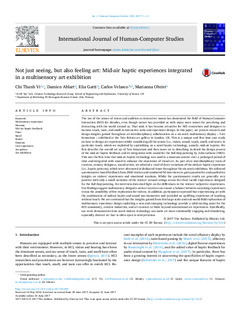| dc.description.abstract | The use of the senses of vision and audition as interactive means has dominated the field of Human-Computer Interaction (HCI) for decades, even though nature has provided us with many more senses for perceiving and interacting with the world around us. That said, it has become attractive for HCI researchers and designers to harness touch, taste, and smell in interactive tasks and experience design. In this paper, we present research and design insights gained throughout an interdisciplinary collaboration on a six-week multisensory display – Tate Sensorium – exhibited at the Tate Britain art gallery in London, UK. This is a unique and first time case study on how to design art experiences whilst considering all the senses (i.e., vision, sound, touch, smell, and taste), in particular touch, which we exploited by capitalizing on a novel haptic technology, namely, mid-air haptics. We first describe the overall set up of Tate Sensorium and then move on to describing in detail the design process of the mid-air haptic feedback and its integration with sound for the Full Stop painting by John Latham (1961). This was the first time that mid-air haptic technology was used in a museum context over a prolonged period of time and integrated with sound to enhance the experience of visual art. As part of an interdisciplinary team of curators, sensory designers, sound artists, we selected a total of three variations of the mid-air haptic experience (i.e., haptic patterns), which were alternated at dedicated times throughout the six-week exhibition. We collected questionnaire-based feedback from 2500 visitors and conducted 50 interviews to gain quantitative and qualitative insights on visitors’ experiences and emotional reactions. Whilst the questionnaire results are generally very positive with only a small variation of the visitors’ arousal ratings across the three tactile experiences designed for the Full Stop painting, the interview data shed light on the differences in the visitors’ subjective experiences. Our findings suggest multisensory designers and art curators can ensure a balance between surprising experiences versus the possibility of free exploration for visitors. In addition, participants expressed that experiencing art with the combination of mid-air haptic and sound was immersive and provided an up-lifting experience of touching without touch. We are convinced that the insights gained from this large-scale and real-world field exploration of multisensory experience design exploiting a new and emerging technology provide a solid starting point for the HCI community, creative industries, and art curators to think beyond conventional art experiences. Specifically, our work demonstrates how novel mid-air technology can make art more emotionally engaging and stimulating, especially abstract art that is often open to interpretation. | nb_NO |
